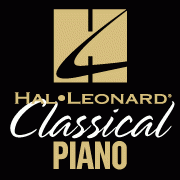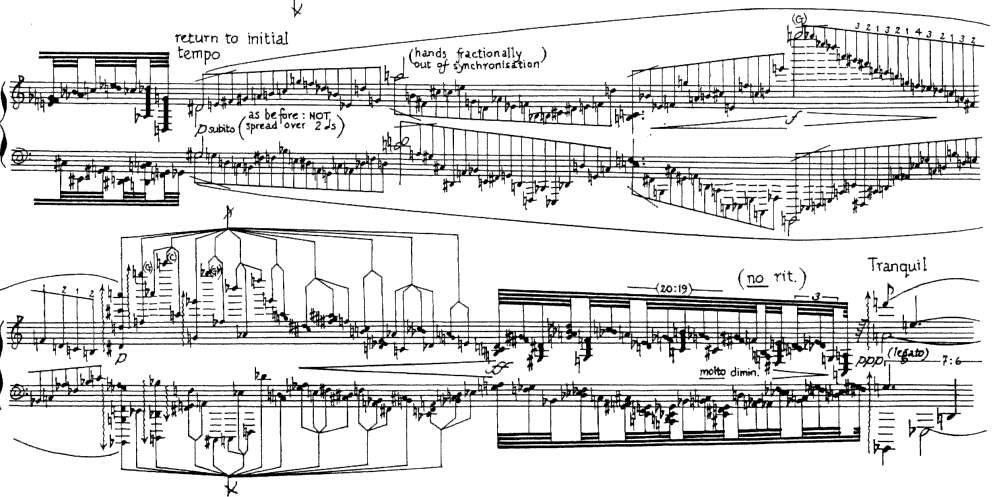The previous post on this topic basically spotlighted a generation. Four of the five composers were born within a year of each other. The list below is a bit more scattered, but it represents a snapshot of some continuing trends. Auerbach and Liebermann carry the torch for traditional piano development and focus on harmony. Vine falls slightly outside of that school but also embraces harmony. Finnissy and Wubbels shatter some boundaries and often leave triadic harmonic behind, but their work commands our attention.
Michael Finnissy (b. 1946, British)
The name Finnissy is enough to make many pianists and listeners shudder. He belongs to the New Complexity school, churning out works of fearsome difficulty and density. But unlike the music of Brian Ferneyhough and some other peers, I hear some really compelling expression and emotion here. The piano is uniquely capable of creating complex textures, so let’s celebrate it!
Key pieces:
English Country Tunes. Earth-shaking clusters and scrambles across the keyboard are juxtaposed with serene, naked melodies. Frequently riveting in its intensity. (Score)
The History of Photography in Sound. I haven’t listened to this whole piece yet (it’s over an hour long), but I like what I’ve heard. It’s a great big novel of a piece to savor like a fine wine. (Part I Score) (Part II Score) (Part III Score)
Carl Vine (b. 1954, Australian)
Carl Vine’s music sparkles with rhythmic propulsion. His sonatas are big, bold, and energetic (No. 1 and 3 were in consideration for my ranking of top 5 contemporary sonatas), and he has a special knack for toccata-like fast movements. What excites me about Vine is that he’s written some of his best work in the twenty-first century. There’s still hope!
Key pieces:
Sonata No. 1 (1990). Infectious rhythms, cascading harmonies, and a sense of discovery in its development that makes for a memorable ride. (Score)
Sonata for Piano 4 Hands (2009). Tremendously exciting. This sounds like so much fun to play. (Score)
The Anne Landa Preludes (2006). Very attractive, lyrical miniatures if you don’t feel like taking on a sonata. (Score)
Lowell Liebermann (b. 1961, American)
Of these composers, Liebermann most explicitly embraces traditional piano technique and classical forms, but his music is really well-written. And he’s got a whole banquet of music to choose from.
Key pieces:
Sonata No. 3. Echoes of Prokofiev. Full of juicy piano writing and fun energy. (Score)
Nocturnes. Hard to choose one. All are elegant, expansive essays in the form. Liebermann’s kaleidoscopic harmonies are a perfect fit. (Score)
Variations on a Theme of Schubert. Schubert’s song “Heidenroslein” undergoes some fun, wacky alterations in this set. (Score)
Lera Auerbach (b. 1973, Russian)
Auerbach takes a fairly traditional approach to musical materials and writes music in a relentlessly dark, brooding mood. Some of it feels like an extension of Schnittke’s darker creations. She’s a talented pianist, and her generous discography for the instrument is worth looking into.
Key pieces:
24 Preludes for Piano, Op. 41 (1998). Melancholy moods tempered by rhythmic impulses that remind me of Shostakovich. (Score)
Images from Childhood, Op. 52 (2000). Miniatures written at a student level with memorable melodic gestures and moments of drama. (Score)
Eric Wubbels (b. 1980, American)
I’m a little bit biased on Wubbels because he might be my favorite living composer, period. But as the pianist of the Wet Ink Ensemble, he brings great insight and imagination to everything he writes: compelling usage of extreme registers, string preparations, occasional nods to the piano tradition, and contrasts between virtuosic maximalism and quiet, nuanced passages that focus on resonance.
Key pieces:
Psychomechanochrometer (2013). A wild prepared-piano essay with wonderfully vivid gestures. (Score)
Consolation (2004). I sequenced this into MIDI myself from a score PDF (it was a fun project) and what I heard was a melting pot of influences from Sorabji to Reich. Fascinating stuff.
Duos with Piano (2007-). Yeah, I know it’s not solo piano, but in this series of pieces with alto sax, violin, cello, and other instruments, Wubbels explores the piano almost as much as the instrument of focus.
A final note: as long as we’re talking about contemporary rep, I feel the need to recognize a piano piece that kind of blew my mind in terms of extended techniques and seems to orbit in the farthest reaches of the piano solar system. Say hello to Simon Steen-Andersen’s rerendered (2003) for pianist and 2 assistants.


Personally I dislike Brian Ferneyhough’s (and many other composers’) pretentious unfounded alien-styled inhumane chaotic pseudo-random material, which exists only for it’s own sake and creates sensory responses that are not of the composer’s intention, but just happen to occur.
Make no mistake: Ferneyhough is no real composer; and the fact that this has never been accordingly stated or criticized shows the times in which we live: Feed the people any rubbish, with just a hint of added intellectual superiority and they’ll believe it and worship his ‘message’.
… Ferneyhough… the charlatan king of pretentious wishful implication
LikeLike
What about David Hicken?
I was most plesantly surprised when i found him on Youtube. I think many of his pieces are hiden gems. And unlike most of the composers you mentioned in your article, his music appeal to a verry large audience.
LikeLike